Two OMAP 3430 Phones: Nokia N900 and Motorola Droid
by Brian Klug on June 10, 2010 9:29 PM EST- Posted in
- Smartphones
- N900
- Maemo
- Motorola Droid
- Droid
- MeeGo
- Android
- Mobile
Middling Performance
To measure performance, I continued using the WiFi page loading test methodology Anand described in his HTC Droid Incredible review, and also added in a few other tests that are android specific.
Our first test is loading the AnandTech.com front page, where we've got lots of text and images to stress bandwidth and parsing.
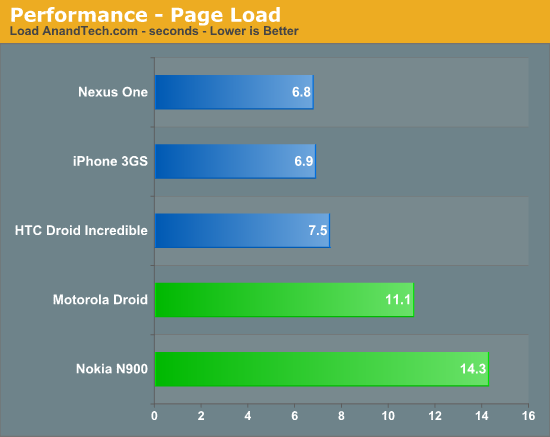
Next is the very intensive engadget.com homepage load. There are a number of flash elements here, taxing the HTC Incredible and N900 alike.
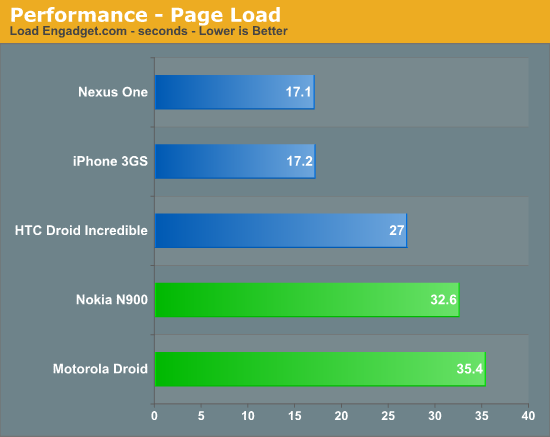
We also continue to run the SunSpider 0.9 JavaScript benchmark. This interestingly enough will illustrate the huge JavaScript performance delta between the N900's Maemo browser and the Android browser, however the comparison across Android devices gives a good idea how much the OMAP 3430 differs from the Qualcomm Snapdragon.
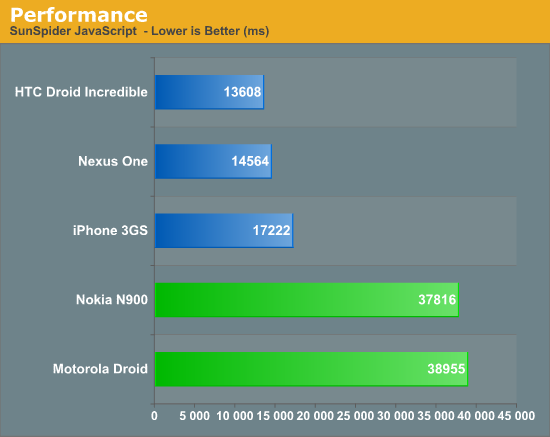
Common to the Android platform are two benchmarking applications that have slowly seen a rise in popularity - Linpack for Android and Benchmark Pi. Here we can get a good idea of the performance difference between the OMAP 3430 and the Snapdragon SoCs.
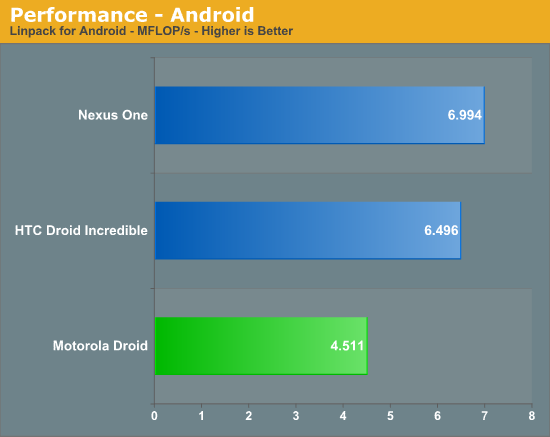
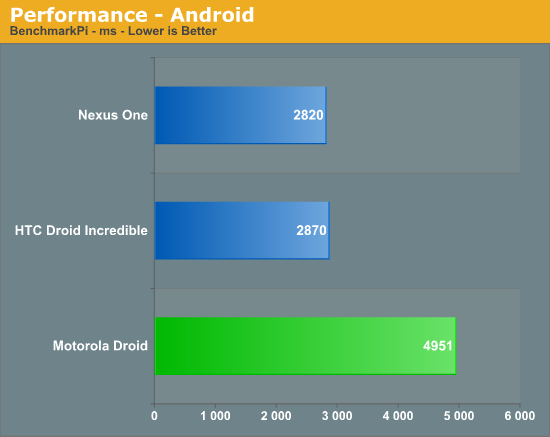
We can see that the OMAP 3430 holds its own, but still just isn't as fast as the 1 GHz Snapdragon SoC. What's interesting here is that the Motorola Droid's Cortex A8 is running at 550 MHz, some 81% slower than the 1 GHz Snapdragon. However, the performance difference between the two is only 44% for Linpack. Benchmark Pi numbers are closer to the kind of scaling I'd expect, as the 81% increase in clock speed results in a 73% faster compute time.
In practice the N900 is undoubtably a snappy phone. While using Maemo, I never once wanted for more power, even though users have successfully achieved 1 GHz or more on the OMAP 3430 in the N900 and Motorola Droid. Only after getting 8 or more webpages open did I really start to notice any lag or slowdowns at all. On the Motorola Droid, Android 2.1 was more than usable, and far faster in practice than the ARM11 class SoCs used in some of the other Android phones, like the 528 MHz Qualcomm MSM7600A or MSM7200A in the HTC Hero.










68 Comments
View All Comments
tarunactivity - Thursday, June 10, 2010 - link
a notable omission:The FM receiver on the N900 requires Bluetooth to be switched on. So if you want FM, you need to plugin your earphones + enable bluetooth.
Kind of counter productive , if you ask me,and surely a waste of power.
Brian Klug - Friday, June 11, 2010 - link
Ahh, you're totally right. I think I glossed over that because I already had Bluetooth on, but it makes sense now since the FM radio is on that same piece of silicon.I wonder how much of a difference it makes on battery - had it disabled for those other tests of course.
-Brian Klug
asdasd246246 - Thursday, June 10, 2010 - link
I'm sure the Nokia has sweet hardware, but it's still all plastic..Plastic screen that will scratch the first 10 minutes you own it, and a friend has a similar model without a keyboard, and the plasticness is so horrible I shudder.. -_-
legoman666 - Thursday, June 10, 2010 - link
I've had the N900 since last November. No screen protector, no case. Not 1 scratch. So speak for yourself, maybe you ought to put your phone in a separate pocket as your keys.legoman666 - Thursday, June 10, 2010 - link
back: http://imgur.com/tf6RE.jpgfront: http://imgur.com/XDsyI.jpg
akse - Friday, June 11, 2010 - link
The case is somewhat plastic yeah.. but it hasn't really bothered me so much. I have only a few tiny tiny scratches on the screen, you can only spot them by mirroring a clean screen against bright light.At the back I have a few bigger scratches because the phone fell on concrete..
Calin - Friday, June 11, 2010 - link
I have a 1200-series Nokia phone, which I keep in the same pocket as the keys, and the display is in a serviceable condition after more than two years of abusearnavvdesai - Thursday, June 10, 2010 - link
Actually, the Symbian OS- Nokia's No.1 Smartphone OS is more open with entire OS(including the core APIs) being Open Source. Symbian is more open than Android.Talcite - Friday, June 11, 2010 - link
That's only true for symbian^3 and newer OSes. Only the Nokia N8 is currently shipping S^3 I believe.You should also mention that the Maemo 5 OS has many binary packages to get all the cellular hardware and PowerVR GPU working.
Anyways, it definitely has more support for the FOSS community than android though as far as I know. You're free to flash your own ROMs without needing to root it and you don't need to do weird stuff with java VMs. Just a simple recompile for ARM and support for Qt I think.
teohhanhui - Friday, June 11, 2010 - link
Nokia N8 is still far from "currently shipping"...